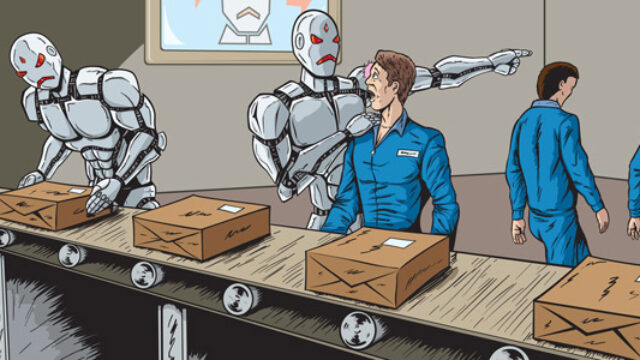AI is Destroying Jobs – Faster Than Expected

The author is an optimist. I’m not. At some point, the S&P will end its upward trend, but job openings will continue to fall. AI isn’t like tractors replacing farmers—an irrelevant analogy. Tractors weren’t anti-human, and their manufacturers weren’t crazed disruptors trying to destroy the world. Arch-technocrat Marc Andreessen predicted last February that “AI will drive down wages” and with it the prices of all goods and services, leading to utopia. Really? A massively deflationary economic crisis is utopia? And those are the idiots leading the destruction of humanity. – Patrick Wood, editor.
By: Adam Sharp
A disturbing chart is causing a stir in the financial world.
It’s a long-term view of job openings (blue) relative to the S&P 500 (black). The dotted line indicates the launch date of ChatGPT in November 2022.
See for yourself:

Digesting this graph gives me heartburn.
As you can see, job openings and the stock market historically moved in tandem. When the economy was doing well, both figures rose. When the economy was doing poorly, they fell.
But in November 2022, this relationship broke like a branch. At that point, OpenAI released its groundbreaking ChatGPT app.
Since then, job openings have collapsed while the S&P 500 has risen to new highs.
AI has simultaneously caused a stock market bubble and job openings to collapse.
AI stocks have been roaring the market with their gains, while the same technology is tearing the job market apart.
Entry-level positions are particularly vulnerable to AI, but it is disrupting the entire labor market for employees.
That’s our new K-shaped economy.
The final warning from the godfather of AI
The four largest US AI spenders alone (Google, Amazon, Meta, and Microsoft) plan to spend $420 billion on infrastructure next year, primarily GPUs, data centers, and power generation.
Nearly half a trillion dollars, just by the four largest US companies… That’s a $360 billion increase from this year. Global AI spending is expected to surpass $1.5 trillion next year.
The ‘godfather of AI’, Geoffrey Hinton, says this level of spending can only be justified by replacing humans:
“I think the big companies are betting that there will be a massive job displacement by AI because that’s where the big money is made….
I think that to make money you will have to replace human work.”
That indeed seems to be the only logical explanation.
Of course, there’s a chance that Big Tech will overspend and that AI won’t succeed in replacing a large number of workers. Let’s all hope for that outcome.
But we must prepare for the outcome where AI wins. This technology is only a few years old and already more competent than the average human in many tasks.
The technology has been steadily improving and with so much at stake, further breakthroughs are inevitable.
Just an adjustment phase?
Some will argue that this is simply an adjustment phase. That the market will eventually do its job and adapt to the new reality, finding new opportunities for those displaced by AI.
A common counterargument to AI disruption theory is that tractors displaced farmers and that all was well because those farmers went to work in factories and other jobs created by economic change.
But when tractors revolutionized agriculture, the transition was anything but smooth. In 1910, there were perhaps 1,000 tractors in the world. By 1930, that number had risen to 900,000.
Farm work that once required dozens of men was suddenly done by two. Most farmworkers had to look for new work. If they were lucky, they could find a job in a factory. But that meant moving to a new area, with all the associated costs and difficulties.
While the transition from manual fieldwork to automation seems simple from our modern perspective, in reality it was a long, difficult transformation of the global workforce.
3 years busy
We’ve only been working on AI disruption for three years. And compared to previous technological breakthroughs, like the tractor, this one is happening much faster.
The following chart shows the results of a Wharton study on AI adoption among executives. Currently, 46% of executives report using AI daily. This is an increase of 11% in 2023 and 29% in 2024.
As you can see, a whopping 68% of IT workers use AI daily, up from 21% in 2023. And 39% of lawyers now use AI daily, up from just 9% last year.
The next big step in AI is “agents”: autonomous AI workers capable of carrying out a task from start to finish with little oversight.
AI agents aren’t yet ready to directly replace human workers. But they can already increase productivity and enable one person to do the work of two or three.
Don’t kid yourself. Widespread disruption is on the horizon. Those who use AI effectively will become hyper-productive. Those who don’t risk falling behind or even being laid off.
I’m confident the economy will eventually adapt to this new reality and find productive ways for all workers to contribute. But we don’t know how long that will take.
Every great technological leap begins with a breakthrough. The loom, the steam engine, the tractor, and the computer. Each improved the world over time, but each involved a difficult adjustment period.
AI could prove to be the most disruptive of all. An unprecedented redistribution of the global workforce, condensed into a single decade.
The world of work will be severely disrupted for a while. For many young people today, a blue-collar career might be the better choice. The era of “everyone should go to college and get an office job” is coming to an end.
My 16-year-old son wants to learn a craft, maybe even start his own business, and I fully support that. It will be a while before robots can do most manual labor.
And in the long run, this shift will likely be a good thing for the world. We need to start building and manufacturing things again. More welders and fewer email jobs.
Yes, it will be painful. But eventually, we’ll get to a point where algorithms do most of the hard work, and people perform creative and productive tasks in the real world.
In time, it will sort itself out. But for a while, it will feel like the end of the world as we know it.
https://www.frontnieuws.com/een-grafiek-die-alles-zegt-ai-vernietigt-banen-sneller-dan-gedacht

